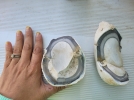
Rocks & Fossils
Check out our rock and fossil FAQ for smart collecting tips, information about some local rock formations, and advice about fossil eggs and meteorites.
- Anthropology
- Rocks & Fossils
- Invertebrates
- Vertebrates
- Botany
- Astronomy
- Fungi
- General
- Recently Asked
Fossilized Egg?
Hello,
I was kayaking in a northern MN mine pit and it's very unusual and as big as my hand and it's cracked in half but I have the two pieces. The inside almost looked like a giant jawbreaker candy.
I am curious to what it might actually be..




Curator Response
Hi Laci,
Rocks have so many ways to masquerade as fossil eggs! This is a great example of how a geological structure can look like a biological one. This is what geologists call a concretion. We have answered many questions about concretions pretending to be ancient eggs. As we noted in our answer to another question, a concretion is a “rounded lump of rock that accumulated around a nucleus of something different from the rest of the ‘host rock’ where it formed.” So concretions can get cool multicolored layers like the ones you see on yours...but it’s more like a malt ball than an egg! The layers aren’t traces of life, but of the presence of different mineral substances. Rocks can also build distinctive layers—sometimes called rinds—through weathering, discussed more in this answer. This concretion of yours is a very nice-looking concretion with distinctive layers, so we appreciate your sharing it with us and look forward to using it as another example of a cool eggy-looking rock.
In this case, the layers look like bands of chalcedony, also known as microcrystalline quartz. (Agate and jasper are varieties of chalcedony of which you may have heard. They are translucent and opaque, respectively.) Chalcedony forms from silica-rich groundwater.
Sometimes there are fossils inside concretions, but we don’t see any inside this one. However, it may still have more to tell you about the past. We recommend reaching out to geologists in Minnesota with more detailed information about where you found this. They may be able to tell you what specific rock formation it comes from, and when it formed.
Stay curious,
Dibblee Curator of Earth Science Jonathan Hoffman, Ph.D., and Nature Education Manager Sabina Thomas, Ph.D.
Laci response:
Thank you so much for your quick response. It's such a cool rock although an egg would have been so much cooler. But I appreciate your expertise and taking the time to answer me. We are pretty excited to learn more from MN too. THANKS AGAIN

